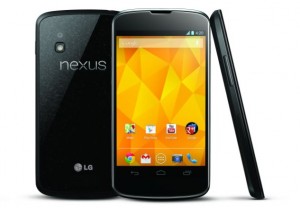Google’s Nexus 4 phone
Google and LG confirmed today the long leaked Nexus 4 smartphone, which will run on Android 4.2.
The Nexus 4 marks the first Nexus device built by LG, with Google looking to expand its partnerships and keep some of its partners thriving in the brutally competitive smartphone business.
“This is the first time we collaborated with LG to build a Nexus device” – Andy Rubin, who runs Android at Google, said in a statement. “They brought an extraordinary amount of talent to the project, and the result is a feature-packed device that feels great in your hand and blazingly fast under the hood.”
“LG is proud and excited to play this role in helping build the latest Nexus smartphone” – said Jong-Seok Park, CEO of LG Electronics’s mobile arm.
The Nexus 4, as previously reported by CNET, is an altered version of LG’s flagship Optimus G smartphone. The phone is one of the first with Qualcomm’s quad-core Snapdragon processor, and features a 3G connection using GSM and HSPA+ technology. Unfortunately, a 4G LTE model isn’t yet available.
The Nexus program has always had three components – a platform, an OEM and new software. The platform is the SoC and other internal hardware components that define the performance characteristics Google would like to see all manufacturers pursue. The OEM partner works with Google in design and features, and, of course, manufacturing and packaging. At times the platform and OEM have fit hand in glove, with the platform and design hewn from an existing product. We saw this in the Nexus One, which mirrored the hardware HTC was offering in the Droid Incredible and several other models. We saw this again with the Nexus S, which was strikingly similar to Samsung’s Galaxy S, within and without. The Galaxy Nexus was a strange departure, owing its internals to a platform preferred by Motorola, but with a design that foretold Samsung’s next iteration of the Galaxy S family. And now (there’s the Nexus 4) which could have easily been called the Optimus Nexus or the Nexus G, were it not for Google finding a nomenclature they liked.
Even though its New York event was pushed off track by Hurricane Sandy, just as expected, Google announced the fourth-generation Nexus smartphone today. An unlocked device, the LG Nexus 4 will arrive in the Google Play online store on November 13 starting at 299 dollars (8GB). Significantly, the Nexus 4 represents a real opportunity for LG to take some clout away from arch rival Samsung, maker of the previous few Nexus devices. One flaw though is the Nexus 4′s lack of fast 4G LTE but that likely won’t matter to die-hard Android users who crave the swift upgrade path for Google Nexus products.
Google will also sell an unlocked 16GB model for $349, while T-Mobile will offer its own 16GB version for $199 on November 14.
Like the original Nexus One, the LG Nexus 4 delivers the latest version of Google’s Android software – in this case, 4,2 Jelly Bean – without any manufacturer or carrier skins. Some notable improvements to the operating system include what Google calls the Photo Sphere plus Gesture Typing. Photo Sphere is a feature that lets you stitch multiple images from various directions into a 360-degree super panorama. Gesture Typing, as its name implies, is a text input method that allows users to string letters together by dragging fingers through them on the keyboard similar to Swype.
The expansive 4,7-inch display has a 1,280×760-pixel resolution and it’s all driven by a 1,5GHz quad-core Snapdragon processor. LTE is a big miss, and the 8-megapixel camera is not as robust as I’d like, but the handset’s sizable 2GB of RAM and 16GB of internal storage show that LG has finally found its flagship phone
While the Galaxy Nexus showed plenty of curves, the Nexus 4 is all angles and straight lines. Based on the design of the LG Optimus G, it is the very definition of a slab phone. That’s not terrible, but I was hoping for a little more style and perhaps some originality on a Nexus class device, especially from a premier manufacturer such as LG. The display takes up almost the entire front of the device with three touch controls below. The phone’s glossy glass back with embedded sparkles does, however, look distinctive.
